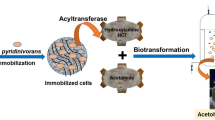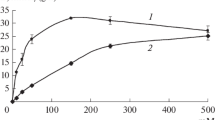Abstract
The influences of concentration of acrylamide, pH, temperature, duration of storage of encapsulated cells and presence of different metals and chelators on the ability of immobilized cells of a Rhodococcus sp. to degrade acrylamide were evaluated. Immobilized cells (3 g) rapidly degraded 64 and 128 mM acrylamide in 3 and 5 h, espectively, whereas free cells took more than 24 h to degrade 64 mM acrylamide. An acrylamide concentration of 128 mM inhibited the growth of the free cells. Immobilized bacteria were slow to degrade acrylamide at 10 °C. Less than 60% of acrylamide was degraded in 4 h. However, 100% of the compound was degraded in less than 3 h at 28 °C and 45 °C. The optimum pH for the degradation of acrylamide by encapsulated cells was pH 7.0. Less than 10% of acrylamide was degraded at pH 6.0, while ca. 60% of acrylamide was degraded at pH 8.0 and 8.5. Copper and nickel inhibited the degradation, suggesting the presence of sulfhydryl (-SH) groups in the active sites of the acrylamide degrading amidase. Iron enhanced the rates of degradation and chelators (EDTA and 1,10 phenanthroline) reduced the rates of degradation suggesting the involvement of iron in its active site(s) of the acrylamide-degrading-amidase. Immobilized cells could be stored up to 10 days without any detectable loss of acrylamide-degrading activity.
Similar content being viewed by others
References
Cassidy MB, Lee M & Trevors JT (1996) Environmental applications of immobilized microbial cells: a review. J. Ind. Microbiol. 16: 79-101.
Caunt P & Chase HA (1988) Biodegradation by bacteria immobilized on celite particles. Bio-Technology 6: 721-725.
Cavins JF & Friedman M (1968) Specific modification of sulfhydryl groups with β-unsaturated compounds. J. Biol. Chem. 243: 3357-3360.
Croll ST, Arkell OH, & Hodge RPJ (1974) Residues of acrylamide in water. Water Res. 8: 989-993.
Dearfield KL, Abernathy CO, Ottley MS, Brantner JH & Hayes PF (1988) Acrylamide: its metabolism, developmental and reproductive effects, genotoxicity and carcinogenicity. Mutat. Res. 195: 45-77.
Dwyer DF, Krumme ML, Boyd BA & Tiedje JM (1986) Kinetics of phenol biodegradation by an immobilized methanogenic consortium. Appl. Environ. Microbiol. 52: 345-351.
Friedrick GC & Mitrenga G (1981) Utilization of aliphatic amides and formation of two different amidases by Alcaligenes eutrophus. J. Gen. Microbiol. 125: 367-374.
Grant DJW & Wilson J (1973) Degradation and hydrolysis of amides by Corynebacterium pseudodiptheriticumNCIB 10803. Microbios 8: 15-22.
Heitkamp MA, Adams WJ & Camel V (1993) Evaluation of five biocarriers as supports for immobilized bacteria: comparative performance during high chemical loading, acid shocking, drying and heat shocking. Environ. Toxicol. Chem. 12: 1013-1023.
Heitkamp MA, Camel V, Reuter TJ & Adams WJ (1990) Biodegradation of ρ-nitrophenol in an aqueous waste stream by immobilized bacteria. Appl. Environ. Microbiol. 56: 2967-2973.
Hirrlinger B, Stolz A & Knackmuss HJ (1996) Purification and properties of an amidase from Rhodococcus erythropolisMP50 which enantioselectively hydrolyzes 2-arylpropionamides. J. Bacteriol. 178: 3501-3507.
Hynes MJ & Pateman JA (1970) The use of amides as nitrogen source by Aspergillus nidulans. J. Gen. Microbiol. 63: 317-324.
Kagayama T & Ohe T (1990) Purification and properties of an aromatic amidase from Pseudomonassp. GDI211'. Agric. Biol. Chem. 54: 2565–2571.
Kaplan, A. 1969. The determination of urea, ammonia and urease. Methods Biochem. Anal. 17: 311-324.
Kearney L, Upton M & McLoughlin A (1990) Enhancing the viability of Lactobacillus plantaruminoculum by immobilizing the cells in calcium-alginate beads incorporating cryoprotectants. Appl. Environ. Microbiol. 56: 3112-3116.
Nagasawa T & Yamada H (1989) Microbial transformation of nitriles. Trends Biotechnol. 7: 153-158.
Nawaz MS, Khan AA, Bhattacharayya D, Siitonen, PH & Cerniglia CE (1996) Physical, biochemical and immunological characterization of a thermostable amidase from Klebsiella pneumoniaNCTR 1. J. Bacteriol. 178: 2397-2401.
Nawaz MS, Franklin W & Cerniglia CE. (1994) Degradation of aliphatic amide mixture by immobilized and non immobilized cells of Pseudomonassp. Environ. Sci. Technol. 28: 1106-1109.
Nawaz MS, Khan AA, Seng JE, Leakey JEA, Siitonen PH & Cerniglia CE (1994) Purification and characterization of an amidase from an acrylamide-degrading Rhodococcussp. Appl. Environ. Microbiol. 60: 3343-3348.
Nawaz MS, Franklin W & Cerniglia CE (1993) Degradation of acrylamide by immobilized cells of Pseudomonassp. and Xanthomonas maltophilla. Can. J. Microbiol. 39: 207-212.
Nishikawa H, Moto Y, Sonada Y, & Miyaki Y (1978) Effects of high molecular coagulants on agricultural crops. Kenkyu Hokoku Gifu Kengyo Gijutsu Senta 10: 5-8.
O'Reilly KT & Crawford RL (1989) Kinetics of cresol degradation by an immobilized Pseudomonassp. Appl. Environ. Microbiol. 55: 866-870.
Rights and permissions
About this article
Cite this article
Nawaz, M.S., Billedeau, S.M. & Cerniglia, C.E. Influence of selected physical parameters on the biodegradation of acrylamide by immobilized cells of Rhodococcus sp.. Biodegradation 9, 381–387 (1998). https://doi.org/10.1023/A:1008383710019
Issue Date:
DOI: https://doi.org/10.1023/A:1008383710019




